Ivoclar Vivadent Vectris User Manual
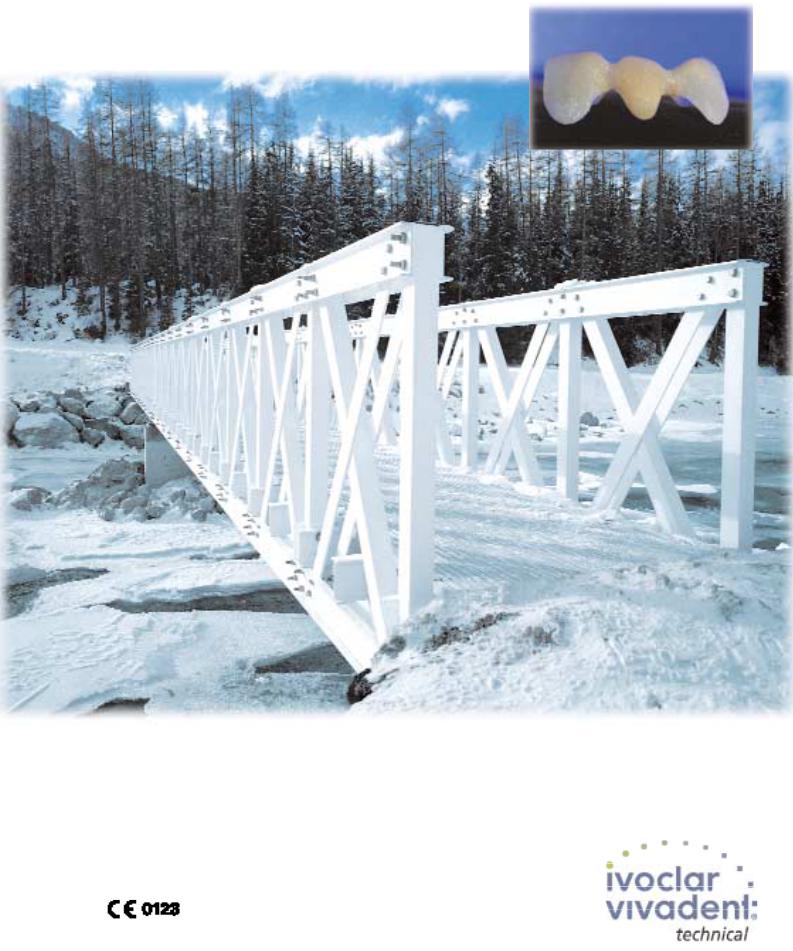
Vectris®
I N S T R U C T I O N S F O R U S E
2

TA B L E O F C O N T E N T S
Product Information
Material |
6 |
|
Product system |
7 |
|
Applications |
8 |
|
Questions & answers |
9 |
|
Composition and storage |
10 |
|
|
||
Working times |
11 |
|
Description of assortments |
|
|
Working Procedure
Preparation |
18 |
|
Framework design |
20 |
|
Cementation |
28 |
|
|
|
|
Single Crowns
Starting situation |
30 |
|
Working method for different preparations |
30 |
|
Fabricating the silicone matrix |
31 |
|
Sealing the dies |
32 |
|
Preparing the die for the vacuum-forming process |
32 |
|
|
||
Vacuum-forming the Vectris Single – Version A |
33 |
|
Vacuum-forming the Vectris Single – Version B |
34 |
|
Removing the framework from the die |
35 |
|
Finishing |
36 |
|
The result |
36 |
|
3-unit anterior bridges
Starting situation |
38 |
Fabricating the duplicate model for the vacuum forming process 38
Contouring the pontic |
39 |
Transferring the pontic to the duplicate model |
40 |
Fabricating the Transil matrix |
41 |
Sealing the dies |
42 |
Preparing the dies for the vacuum-forming process |
42 |
Placing Vectris Pontic into the Transil matrix |
|
and vacuum-forming the pontic |
42 |
Vacuum-forming the Vectris Frame |
44 |
Removing the framework from the die |
45 |
Finishing |
46 |
The result |
46 |
3-unit inlay-retained bridge Starting situation |
48 |
|
Fabricating the duplicate model for the vacuum forming process 49 |
|
|
Contouring the pontic |
50 |
|
Transferring the pontic to the duplicate model |
51 |
|
Fabricating the Transil matrix |
52 |
|
|
||
Sealing the dies |
53 |
|
Preparing the dies for the vacuum-forming process |
54 |
|
Placing Vectris Pontic into the Transil matrix |
|
|
and vacuum-forming the pontic |
54 |
|
Vacuum-forming the Vectris Frame |
56 |
|
Removing the framework from the die |
57 |
|
Finishing |
58 |
|
The result |
58 |
|
3
4
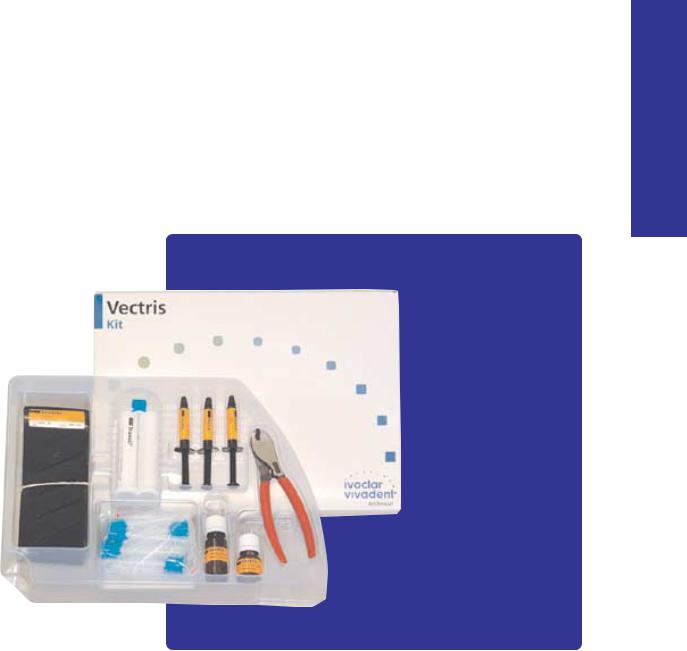
Vectris®
P R O D U C T I N F O R M AT I O N
N O I AT M R O F N I T C U D O R P
5

Vectris®
Metal-free, tooth-coloured, translucent frameworks follow today’s trend in dentistry and offer advanced aesthetic and functional properties. The fibre reinforced framework material Vectris is ideally suited for the fabrication of FRC frameworks (Fibre Reinforced Composite).
FRC technology emulates the principles of natural fibre bonds, which are capable of withstanding the extreme stresses that occur in natural surroundings. FRC materials consist of elastic fibres that are embedded in an organic matrix. This type of structure enables modern dental technology to manufacture FRC frameworks.
Since its introduction, Vectris has been accepted as an alternative to alloys, ceramics and zirconium oxide. Vectris has also proved suitable for reinforcing long-term temporaries. In addition, this innovative material enables dental practitioners to treat clinical cases, such as missing posterior teeth, with a tooth conserving solution, i.e. a Vectrisbased inlay-retained bridge that is cemented in place using an adhesive cementation technique.
In response to the experience gathered over the past few years, the procedure for fabricating Vectris frameworks has been adjusted to allow for a functional framework design that closely resembles the accepted framework design used in the metal-ceramic technique.
We would like to thank Paolo Miceli from Italy for his valuable cooperation in developing the technique presented in these Instructions.
Material
Vectris is a light-curing, translucent, tooth-coloured framework material. It is part of the category of fibre reinforced composites (FRC = Fibre Reinforced Composite).
Vectris consists of several layers of fibre wafers and uniaxially oriented fibre bundles embedded in an organic polymer matrix. This matrix assures a strong bond and homogeneously distributes the masticatory forces exerted on the veneering material throughout the framework.
2 mm
1 mm
6
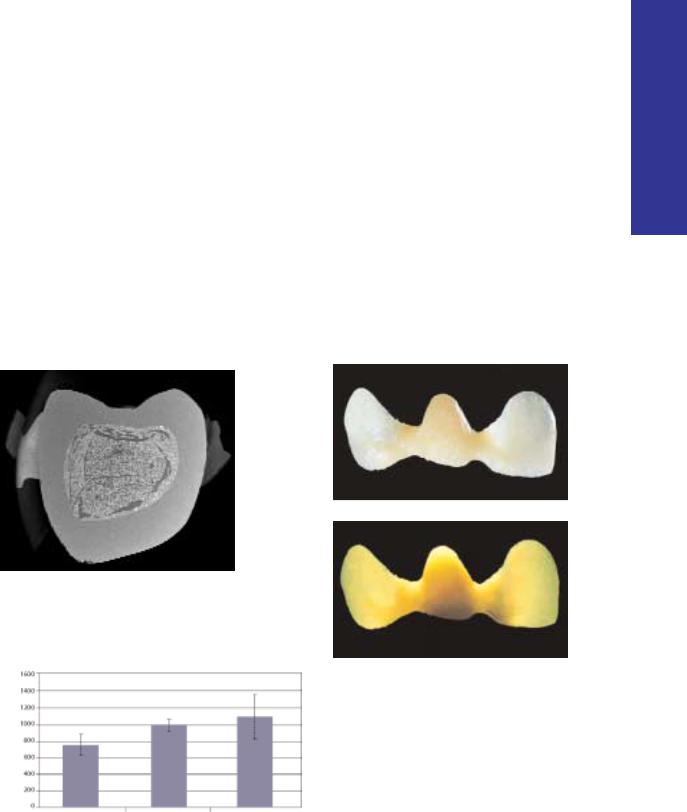
Physical properties
Vectris frameworks are characterized by an intimate stress-free fit and beneficial physical properties thanks to a special manufacturing process that combines the use of vacuum, pressure and light. The frameworks are automatically formed and polymerized in the VS1 framework former. Furthermore, a newly developed working technique – based on the Transil matrix material – facilitates the fabrication of cusp-supporting frameworks. The flexural strength of these frameworks is superior to that of previous FRC frameworks.
Flexural strength of 3-unit posterior bridges using different
framework materials and designs. All frameworks are
veneered with SR Adoro.
Fracture resistance (N) |
|
Vectris framework fabricated |
Vectris framework fabricated With Academy Gold XH |
using the previous technique |
using the Transil technique |
Source: R&D, Ivoclar Vivadent AG, Schaan, 2003
Aesthetic properties
The translucent, tooth-coloured fibre wafers permit the fabrication of highly aesthetic frameworks. Light can pass through the restoration without being blocked by opaque areas of the substructure. The advantage of the FRC framework is also apparent at the transition from the pink tissue colour to the white tooth colour. The grey margins typically associated with metal restorations are not present in Vectris-based reconstructions. The cervical area exhibits a lifelike aesthetic appearance.
N O I AT M R O F N I T C U D O R P
7
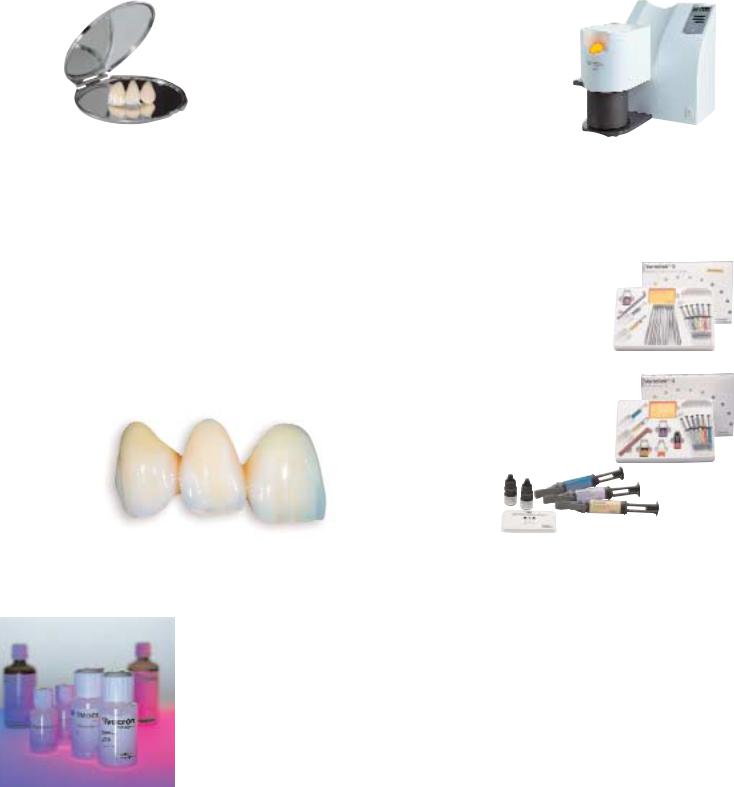
P R O D U C T S Y S T E M
Compatibility with SR Adoro®
The metal-free Vectris frameworks can be veneered with SR Adoro. SR Adoro is a microfilled, light/heat-curing veneering composite for fixed metal-supported and metalfree dental reconstructions.
SR Adoro offers several advantages over glass-filled and hybrid composite materials as regards wear, polishability, handling, plaque resistance and surface finish. Furthermore, the formulation of SR Adoro assures a smooth, non-sticky consistency and endows the material with excellent modelling properties. SR Adoro demonstrates a high degree of translucency as the light refraction index of the matrix and microfiller are coordinated with each other. In addition,
the foundation material of SR Adoro exhibits opalescent characteristics, which are equal to those of the natural tooth in every respect. These characteristics facilitate the fabrication of restorations that exhibit vibrant aesthetic properties. The SR Adoro Liner, which is adjusted to the Vectris framework material, establishes a strong bond with the conditioned Vectris fibres.
Compatibility with SR Ivocron®
SR Ivocron, a clinically proven, high-quality PMMA veneering material, is suitable for the veneering of metal-free long-term temporaries. By choosing the appropriate monomer, SR Ivocron can be processed in a cold-curing, heat-curing or pressure-heat curing technique. Consequently, the processing technique can be matched to the indication in question as well as to the
technician's preferred working technique.
SR Ivocron is available in Chromascop shades. The SR Ivocron system also includes specially coloured cervical materials and is therefore compatible with the SR Vivodent PE shade guide.
Compatibility with Ivoclar Vivadent
apparatus
Vectris VS1 is a high performance, fully automated framework former that has been especially designed for the fabrication of metal-free crown and bridge frameworks. In the VS1, the frameworks are
formed under pressure and then
polymerized with light using a single program.
Compatibility with Ivoclar Vivadent
cementation systems
Select one of the recommended cementa tion systems from the Ivoclar Vivadent range. An array of suitable composite resins are available for the adhesive cementation of metal-free
restorations.
Adhesive cementation:
–Variolink II (CEM Kit Professional Set or
CEM Kit Esthetic Cementation System)
–Multilink
Zirconium oxide temporary cements are suited for the cementation of long-term temporaries that are intended to remain in the oral cavity for a maximum duration of 12 months.
8

A P P L I C AT I O N S
Indication
Adhesive cementation
–frameworks for anterior and posterior crowns
–frameworks for 3-unit anterior and posterior bridges in conjunction with Transil
–frameworks for 3-unit inlay-retained bridges in conjunction with Transil
Temporary cementation
Frameworks for long-term temporaries intended for a maximum duration of wear of 12 months.
Contraindication
–fabrication of bridge frameworks without using Transil
–fabrication of posterior Vectris frameworks without cusp support, if Transil is not used
–Vectris frameworks for bridges consisting of 4 or more units
–Vectris frameworks for inlay-retained bridges consisting of 4 or more units
–cantilever extension bridges
–more than 4 fixed, permanent Vectris units per quadrant
–rehabilitation of quadrants with Vectris frameworks without sufficient support by the remaining tooth structure
–conventional cementation of fixed Vectris restorations
–metal-free temporary restorations intended for a period of wear longer than 12 months
–patients with occlusal dysfunctions or parafunctions, such as bruxism, etc
–patients who practise insufficient oral hygiene
–inability to meet the manufacturer’s preparation guidelines and recommended minimum layer thicknesses
–veneering of permanent Vectris-based restorations using composites that are not indicated for Vectris
–all uses not explicitly stated as indications by the manufacturer
N O I AT M R O F N I T C U D O R P
9

Q U E S T I O N S & A N S W E R S
M O D E L P R E P A R A T I O N
F R A M E W O R K D E S I G N
What material should be used to prepare an
impression that can be poured several times?
A silicone, polyether or similar material should be used for impression taking as these materials provide an optimum reproduction of detail. Additionally, the impressions taken with these materials can be poured several times. Hydrocolloid and alginate materials are unsuitable and cannot be poured more than once.
What if the impression needs to be poured only
once or if it has been damaged during the first
pouring?
In this case, a duplicating impression (Double Take) is prepared with the help of the master model or a multisection model. Then, the impression is poured with type IV stone.
Can the model be cut up into detachable
segments before preparing the duplicating
impression?
Ideally, the model is divided up into detachable segments after the duplicating impression has been prepared. Block out the cut lines with wax, if you have divided up the model first.
What is the minimum thickness for Vectris
frameworks?
Single crowns and bridge abutments must exhibit a minimum framework thickness of at least 0.3. to 0.4 mm. The surfaces should not be ground after the vacuum-forming process has been completed.
What are the dimensions of the connector area
in bridges and inlay-retained bridges?
The connector area between the bridge abutment and pontic should measure at least 3 x 3 mm in bridges and inlay-retained bridges.
What are the appropriate dimensions for the
pontic/abutment contact area (occlusal and
palatal/lingual) when the pontic is placed?
The pontic/abutment contact area should measure at least 3 x 3 mm and should be at least 0.3 mm thick. It is advisable to shape the pontic/abutment contact area in such a way that it supports the cusps. The pontic should reach at least 4 mm into the tooth for inlay-retained bridges.
What are the minimum dimensions of the inlay
box for inlay-retained bridges?
The proximal aspect of the box should be no less than 3.5 mm and the occlusal depth no less than 2.5 mm. Observe the preparation guidelines.
S I L I C O N E M A T R I X
Can you wear latex gloves to process the matrix
material?
Latex gloves inhibit the curing of Transil. Therefore, Transil should not come into direct or indirect contact with latex gloves. For the processing of Transil, use vinyl gloves.
Does Transil need to be used each and every
time?
It is advisable to use Transil each time, as this material clearly improves the adaptation of the Vectris fibres to the model, provides a homogenous layer thickness and facilitates the working procedure. It is imperative to use Transil for the fabrication of bridges and inlay-retained bridges. The only cases that do not require the use of Transil are dies of posterior crowns with a flat occlusal preparation.
Can Transil be applied intraorally?
Transil must not be applied intraorally.
What characteristics should the exterior surface
of the Transil matrix exhibit?
The exterior surface should be as smooth as possible so that it does not hinder the passage of light. Use the accompanying Vectris foil to smooth the exterior surface (prior to polymerization) or use a scalpel (after polymerization). Light becomes scattered on rough, uneven surfaces and, consequently, fails to penetrate the matrix effectively.
How thick should the Transil matrix be?
The matrix should be 3 to 6 mm thick. If it is thinner than that, it may become deformed. If the matrix is thicker, the Vectris material may not polymerize and cure properly.
Is it necessary to apply a Vectris foil if Transil is
used?
It is imperative to apply a Vectris foil only if you do not use Transil. If you use Transil, you may employ the foil to smooth the exterior surface of the silicone matrix while it is still soft.
How long is the working time of Transil?
The working time is approximately 1 minute.
10

V A C U U M - F O R M I N G
What equipment is needed to process Vectris?
A Vectris VS1 framework former is required to process
Vectris.
Can you cut slits into the Vectris Frame?
As Vectris Frame adapts very closely to the die because of the Transil matrix, it is not necessary to cut slits. In fact, cutting slits should be avoided, as the fibres would be severed in the process. This weakens the strength of the restoration.
What happens if the stipulated curing depths
are not observed?
If the stipulated curing depths are not observed, the material
may not be able to polymerize completely. Clinical failure
may ensue.
Is it necessary to sandblast and condition the
pontic before Vectris Frame is applied?
After the vacuum-forming process, any Vectris matrix material that has been squeezed downwards is carefully removed with an appropriate instrument. Then, the Vectris frame is directly applied on the inhibition layer of the pontic (avoid contamination). Next, the Transil matrix is placed on the die and the vacuum-forming process in the VS1 is started. The inhibition layer provides a bond to the Vectris Frame.
Do you ever sandblast and condition the pontic?
Only sandblast and condition the pontic if you have modified the pontic surfaces by grinding and removed the inhibition layer in the process.
N G |
What do I need to watch out for while carrying |
|
I |
out the sandblasting (conditioning) process? |
|
N |
||
Use Al2O3 of a grit size of 80 to 100 microns (type 100) at a |
||
O |
||
pressure of maximum 1 bar (14.5 psi). |
D I T I |
How long is the reaction time of the wetting |
|
N |
liquid? |
|
|
|
|
C O |
Allow the liquid to react for 1 minute. |
|
|
|
|
|
|
|
G |
|
|
|
Can frameworks made of Vectris be veneered |
|||
NI |
with composites that are not explicitly recom- |
||
|
|||
R |
mended by the manufacturer? |
||
Fixed, adhesively cemented restorations made of Vectris |
|||
E |
|||
must not be veneered with any other materials than those |
|||
E |
|||
recommended by the manufacturer. Temporarily cemented |
|||
N |
|||
long-term provisional restorations, which are intended to |
|||
E |
remain in the oral cavity for no longer than 12 months, may |
||
V |
be veneered with other composites. |
||
|
|||
|
|
|
|
N O I AT M R O F N I T C U D O R P
11

C O M P O S I T I O N
–Vectris Single
Dimethacrylate (48-50 wt%); glass fibres (44–46 wt%); silicon dioxide (5–6 wt%). Additional ingredients: stabilizers, catalysts and pigments (<1 wt%)
–Vectris Pontic
Dimethacrylate (30–32 wt%); glass fibres (64–66 wt%); silicon dioxide (3–4 wt%). Additional ingredients: stabilizers, catalysts and pigments (<1 wt%)
–Vectris Frame
Dimethacrylate (44-46 wt%); glass fibres (49–51 wt%); silicon dioxide (5–6 wt%). Additional ingredients: stabilizers, catalysts and pigments (<1 wt%)
–Vectris Glue
Dimethacrylate (38–40 wt%); barium glass filler and silicon dioxide (59–61 wt%).
Additional ingredients: stabilizers, catalysts and pigments (< 1 wt%)
–Vectris Wetting Liquid
Silane in a water/alcohol solution
–SR Model Separator
Polyglycol, polyethylene glycol in a water/alcohol solution
–Transil
Vinyl polysiloxane, polymethylhydrogen siloxane, organic platinum complex and silicone dioxide
Warning
Vectris has been developed solely for use in dentistry. Prevent contact of the eyes and skin with uncured material (Vectris fibres). If the material comes into contact with the skin, rinse with copious amounts of water. Contact of the skin with uncured material may cause slight irritation and sensitization to methacrylate. Use suction equipment and a protective mask when grinding the material. Finishing the Vectris frameworks creates glass fibre dust, which may cause the skin to itch. Wearing suitable gloves is recommended. Thoroughly clean the skin that has come into contact with glass fibre dust. Many commercially available protective gloves do not provide effective protection against the sensitizing effect of methacrylates. Observe the danger signs and notes on the primary packaging and labels of the individual materials.
Interaction
Latex gloves have an adverse effect on the polymerization of polyvinyl siloxanes. For this reason, Transil must not come into direct or indirect contact with latex gloves. It is advisable to use vinyl gloves or to thoroughly wash and rinse the hands prior to using Transil.
General
Ignoring the stipulated contraindications or limitations on the use of the material (Questions & Answers) may result in the clinical failure of the restoration fabricated. Make sure to use original Ivoclar Vivadent materials and equipment when fabricating prosthetic reconstructions with Vectris.
Side effects
Side effects are not known to date. In rare cases, an allergic reaction may occur. Vectris must not be used if the patient is suspected or known to be allergic to any of the material’s ingredients.
Storage
–Store unopened and opened packages of Vectris framework material at 18–25 ºC (64–77 ºF).
–Store opened Vectris packages in a place that is protected from light and use up the contents as soon as possible.
–Reseal Vectris Glue immediately after use (exposure to light may result in premature polymerization).
–Store Transil at 12–28 ºC (54–82 ºF).
–Observe the notes on the storage and dates of expiration of the individual packages.
–Do not use materials after the date of expiration.
–Keep out of the reach of children.
Note on the cleaning of Vectris restorations
Ultrasonic cleaning liquid is very aggressive. If used inappropriately, the topmost layer of the composite surface may dissolve. Do not use basic cleaning liquids that have a pH-value higher than 8.
12

W O R K I N G T I M E S
Vectris materials are sensitive to light. The working time of the material depends on the layer thickness and the prevailing light conditions. The times listed below represent mean values at a light intensity of 3000 lux, which corresponds to the light encountered in a well-lit working space. Be aware of the maximum time limit when removing the Vectris framework materials from the packaging.
|
Working time |
Vectris Single |
2 minutes and 30 seconds |
Vectris Pontic |
3 minutes |
Vectris Frame |
2 minutes and 30 seconds |
Vectris Glue |
2 minutes and 30 seconds |
|
|
N O I AT M R O F N I T C U D O R P
13

D E S C R I P T I O N O F A S S O R T M E N T S
Vectris Kit |
Delivery form |
||
|
Vectris Kit |
||
|
– |
4x4 Vectris Single |
|
|
|
dimensions: diameter: 24 mm |
|
|
– |
2x2 Vectris Pontic |
|
|
|
dimensions: length: 150 mm |
|
|
– |
4x4 Vectris Frame |
|
|
|
dimensions: length: 40 mm; width: 25 mm |
|
|
– |
3x |
2 ml Vectris Glue |
|
– |
1x |
5 ml Vectris Wetting Liquid |
|
– |
1x |
25 Vectris Foil |
|
– |
1x |
10 ml Vectris Model Separator |
|
– |
Vectris Pliers |
|
|
– |
2x |
50 ml Transil Cartridge |
|
– |
12 Mixing Tips |
|
Vectris Single
Vectris Single is suitable for fabricating frameworks for anterior and posterior crowns.
Vectris Pontic
Vectris Pontic is employed to create cusp-supporting pontics or to reinforce the cusps in single crowns. Vectris Pontic is characterized by high flexural strength. As the pontic is wrapped in foil, it can be easily measured out and cut to size. These strips, when cut, are fitted into the Transil matrix one by one.
Vectris Frame
Vectris Frame is wrapped around the cusp-supporting pontic and bridge abutments. This technique results in a bridge framework with having physical properties. The flexible structure of Vectris Frame evenly distributes the masticatory forces on the bridge and increases the torsional resistance.
14
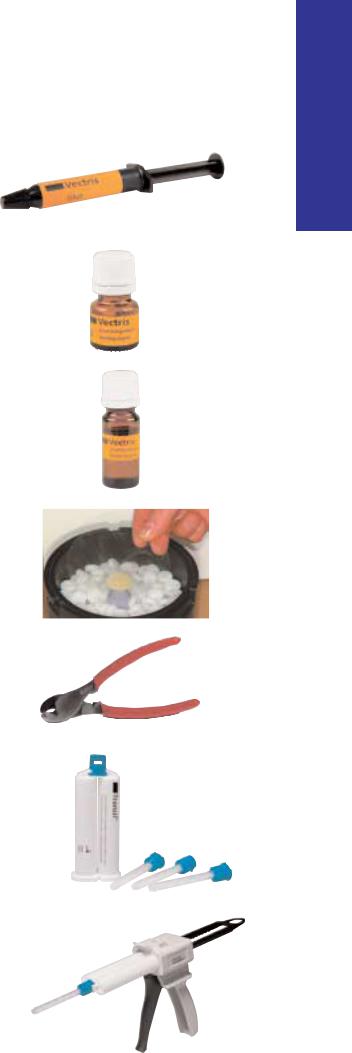
Vectris Glue
Vectris Glue holds the Vectris material in place in the Transil matrix until the vacuum-forming process is carried out and serves as an additional aid to adaptation.
Vectris Wetting Liquid
The wetting liquid is applied to condition the fully completed surfaces of Vectris frameworks in order to achieve an effective bond to the following Vectris material and the SR Adoro Liner.
Vectris Model Separator
The Vectris Model Separator is suitable for separating working dies during the fabrication of metal-free restorations and adjoining stone surfaces during composite veneering.
Vectris Foil
The foil reduces the formation of an inhibited layer during the lightcuring process and, consequently, enables the framework material to cure completely. The foil is only used for applications without Transil.
Vectris Pliers
These pliers are used to cut Vectris Pontic to size.
Transil
Transil is utilized to manufacture reproducible, cusp-supporting Vectris frameworks. This silicone enables users to design frameworks according to the classic metal-ceramic technique. Transil offers easy and fast handling properties. The disposable mixing tips are used to mix the two components to a homogeneous mixture. Cuspsupporting, anatomically designed Vectris frameworks provide increased strength and reduce the risk of delamination.
Dispenser
The dispenser is suitable for Ivoclar Vivadent materials that are mixed in a 1:1 ratio (e.g. Gingitech, Virtual, etc).
N O I AT M R O F N I T C U D O R P
15
16
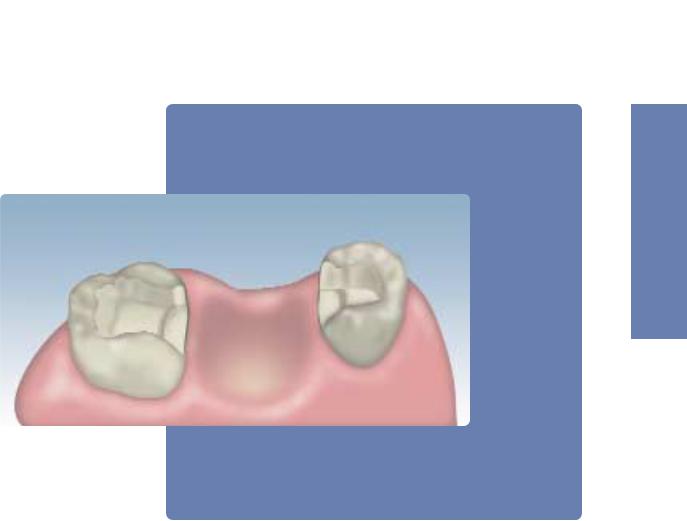
Vectris®
W O R K I N G P R O C E D U R E
E R U D E C O R P G N I K R O W
17
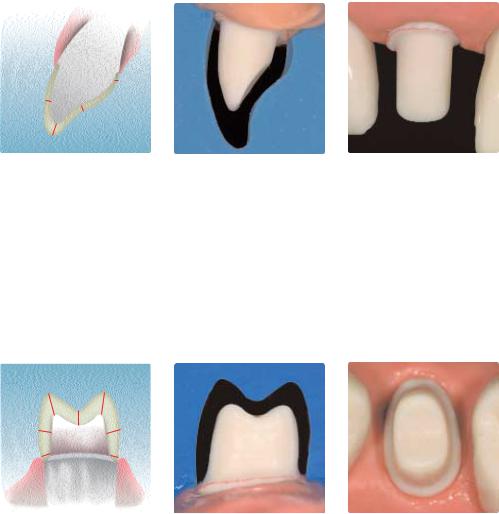
P R E PA R AT I O N G U I D E L I N E S A N D M I N I M U M
R E Q U I R E M E N T S F O R V E C T R I S F R A M E W O R K S
As Vectris restorations are luted in place using an adhesive cementation method, a tooth-conserving preparation technique can be used.
Anterior crowns and bridge abutments
Evenly reduce the anatomical shape and observe the stipulated minimum thickness. Prepare a 360° shoulder with rounded inner edges or a deep chamfer of at least 0.8 mm. For anterior crowns, the labial and/or palatal/lingual surfaces should be reduced by at least 1.0 mm. Reduce the incisal crown third by at least 1.5 mm. Prepare smooth, rounded transitions so that no internal line angles or edges are present.
0.8 
0.8
≥ 1
≥ 1
1.5
Posterior crowns and bridge abutments
Evenly reduce the anatomical shape and observe the stipulated minimum thickness. Prepare a 360° shoulder
with rounded inner edges or a deep chamfer. For posterior crowns, reduce the labial and/or palatal/lingual
surfaces by at least 1.0 mm. Reduce the occlusal crown third of posterior teeth by at least 1.5 mm. Prepare
smooth, rounded transitions so that no internal line angles or edges are present.
1.5 1.5
1.5
≥ 1 |
≥ 1 |
0.80.8
18
